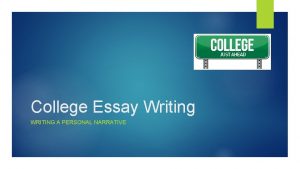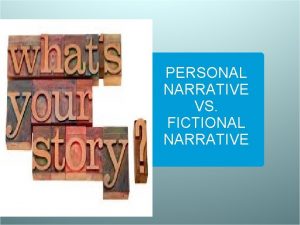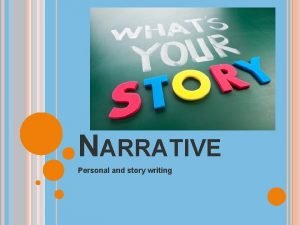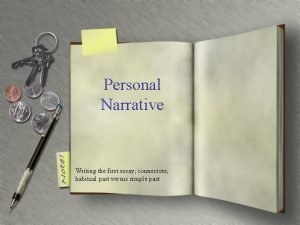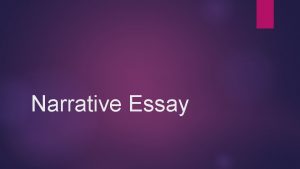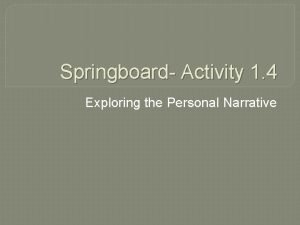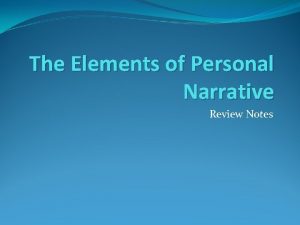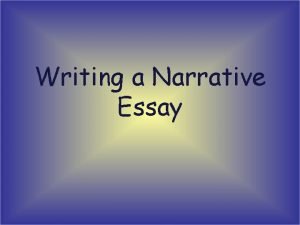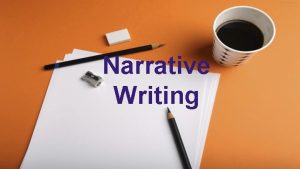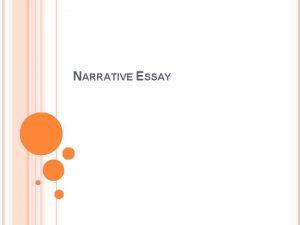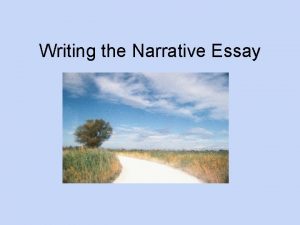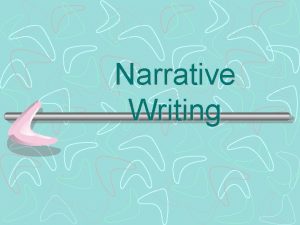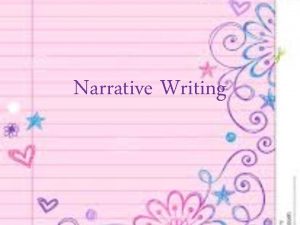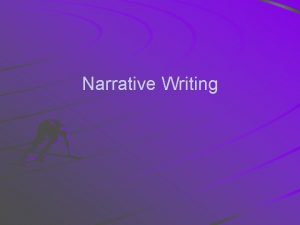College Essay Writing WRITING A PERSONAL NARRATIVE You








- Slides: 8

College Essay Writing WRITING A PERSONAL NARRATIVE

You have a topic, what’s next First we need to determine, where your story should begin. Start by listing the events in chronological order Are there any previous events that the audience would benefit from knowing in order to understand your story and you better? These events could be used as flashbacks. This should help to give your narrative a plan and focus.

Common Core Narrative Standards Write narratives to develop real or imagined experiences or events using effective technique, wellchosen details, and well-structured event sequences. (CCSS. ELA-Literacy. W. 11 -12. 3) Engage and orient the reader by setting out a problem, situation, or observation and its significance, establishing one or multiple point(s) of view, and introducing a narrator and/or characters; create a smooth progression of experiences or events. (CCSS. ELA-Literacy. W. 1112. 3 a) Use narrative techniques, such as dialogue, pacing, description, reflection, and multiple plot lines, to develop experiences, events, and/or characters. (CCSS. ELA-Literacy. W. 11 -12. 3 b) Use a variety of techniques to sequence events so that they build on one another to create a coherent whole and build toward a particular tone and outcome (e. g. , a sense of mystery, suspense, growth, or resolution). (CCSS. ELA-Literacy. W. 11 -12. 3 c) Use precise words and phrases, telling details, and sensory language to convey a vivid picture of the experiences, events, setting, and/or characters. (CCSS. ELA-Literacy. W. 11 -12. 3 d) Provide a conclusion that follows from and reflects on what is experienced, observed, or resolved over the course of the narrative. (CCSS. ELA-Literacy. W. 11 -12. 3 e)

Introduction Engage and orient the reader by setting out a problem, situation, or observation and its significance, establishing one or multiple point(s) of view, and introducing a narrator and/or characters; create a smooth progression of experiences or events. (CCSS. ELA-Literacy. W. 11 -12. 3 a) What this means for this assignment: • Establish your point of view and voice • Set up the problem, situation (introduce your topic) and at least hint at its significance. • Your introduction should not be very long – just a few sentences.

Body Paragraphs Use a variety of techniques to sequence events so that they build on one another to create a coherent whole and build toward a particular tone and outcome (e. g. , a sense of mystery, suspense, growth, or resolution). (CCSS. ELALiteracy. W. 11 -12. 3 c) In this format long body paragraphs should be avoided. Recall events in a way that builds towards the resolution, the significance, the epiphany (the aha! Moment)

Narrative Techniques Use narrative techniques, such as dialogue, pacing, description, reflection, and multiple plot lines, to develop experiences, events, and/or characters. (CCSS. ELA-Literacy. W. 11 -12. 3 b) Although you are limited on the number of words, develop what is important in the story – you!

Conclusion Provide a conclusion that follows from and reflects on what is experienced, observed, or resolved over the course of the narrative. (CCSS. ELA-Literacy. W. 11 -12. 3 e) What this means for this assignment: • You need to reflect on this experience to make it clear to your audience why this experience is meaningful.

Editing Demonstrate command of the conventions of standard English capitalization, punctuation, and spelling when writing. (CCSS. ELA-Literacy. L. 11 -12. 2 Observe hyphenation conventions. (CCSS. ELA-Literacy. L. 11 -12. 2 a) Common errors in previous papers: Comma splices, capitalization of proper nouns, apostrophes, fragments Everyone should use a semicolon and a dash in their paper.
 Personal narrative college essay
Personal narrative college essay Fictional narrative story
Fictional narrative story Personal narrative vs fictional narrative
Personal narrative vs fictional narrative Connectors in essay
Connectors in essay Personal narrative essay examples
Personal narrative essay examples Writing a personal narrative episode 4
Writing a personal narrative episode 4 Elements of personal narrative
Elements of personal narrative Writing a narrative application essay quiz
Writing a narrative application essay quiz What is the purpose of narrative paragraph
What is the purpose of narrative paragraph
